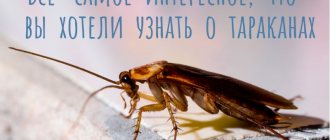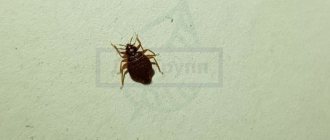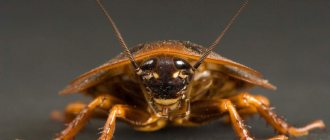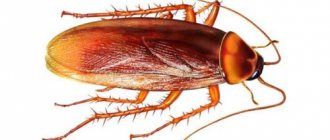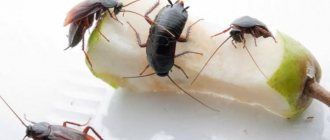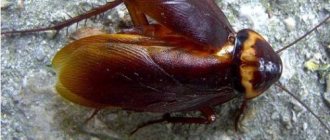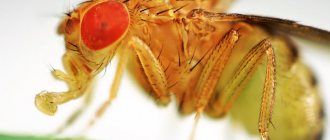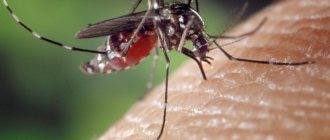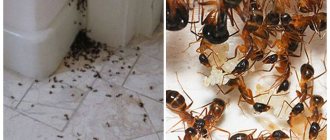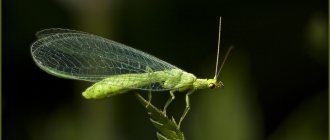The American cockroach is a species of insect native to Africa. They began to spread throughout the world back in the 17th century by sea. They are called American because the cockroach has taken root well in the USA. The American cockroach adapts well to any conditions. That is why it can be found all over the world (except Antarctica), as well as in Russia, where there are severe frosts.
It is mainly the red type of cockroaches that takes root indoors, while black ones are rare due to their increased thermophilia. In apartment conditions, cockroaches can multiply and form entire colonies. The main habitats are thermal collectors, batteries, heaters, ventilation, sheathing, greenhouses, and basements. The warmer the environment, the higher the insect's reproduction rate. Cockroaches go out in search of food at night, live in groups, there is no distribution of roles in the colony, but the colony makes the decision to migrate jointly.
Colonies of American cockroaches are dangerous to health because they carry bacteria and pathogenic microflora and cause allergies.
Who is he and what does he look like, photo
The American cockroach is a native of Africa, brought to the American continent, where it settled permanently. Insects have spread throughout European countries due to their good adaptability to changing living conditions.
Outwardly, they resemble a Prussian, but differ in size. Prussians have a height of 1.5 mm. A distinctive feature is also the pattern on the upper part of the back; in Prussians these are two dark longitudinal stripes.
Adult cockroaches have an elongated body that is red-brown, dark brown or light tan in color. The body is elongated and slightly flattened in the horizontal plane. The larvae, or nymphs, do not have a flying apparatus and are small in size. They have a fixed segmentation of the abdomen, and in an adult individual it is an imago, that is, it is completely covered with wings. The length ranges from 2.8 to 4.4 cm. Females are always larger than males, whose length reaches 3.6 cm. A female can be identified by its chitinous elytra - they are shorter than the abdomen. In males, the elytra completely cover the body, which is why they appear more massive than females.
In the middle of the back, American cockroaches of any sex have a light yellow stripe, which is considered the main characteristic of the species. The head has an elongated shape and long antennae. The legs are long with claws and suckers, and there are sharp spines on the shins. Insects of this species can make small jumps and also fly. This type of cockroach can run a distance of 75 cm in a second.
Like all cockroaches, American cockroaches also have:
- The mouthparts are of a gnawing type and have hard chitinous teeth. The insect's jaws are strong, capable of chewing a hole in denim if there is no more attractive food.
- Developed, large and reticulated wings. In males they protrude beyond the edge of the abdomen by 5-9 mm. Due to the specific shape of its wings, the American cockroach can stay in the air, actively flapping them when jumping from a hill.
- Plate. Both sexes of insects have segmented processes at the end of the body, which are called cerci. Males have a genital plate similar in appearance to the cerci, but smaller in size.
- Long antennae, which consist of segments and act as a tactile organ, sensitive to surfaces of different types, air vibrations and sound waves.
- Large, faceted eyes located on the sides of the triangular head. These insects have a unique visual field, thanks to which they are able to see in all directions at once.
In the photo you can clearly see the elongated shape of the head with antennae, a gnawing apparatus with chitinous teeth, legs with long claws and suckers, and elytra. Visualization helps to see the dark brown or light red body color specific to the American cockroach.
Social structure and reproduction
Female cockroaches do not need a male to lay eggs, but they do enjoy company. A new study shows that virgin female cockroaches living socially produce offspring faster than virgin females living alone.
It's not particularly pleasant to imagine happening under the refrigerator, but female American cockroaches can produce eggs through parthenogenesis, a type of asexual reproduction. Like many other arthropods that can reproduce in this way, cockroaches tend to only do so if males are not available. Offspring born through parthenogenesis develop only from the mother's egg, so they have less genetic diversity than offspring created by sexual reproduction.
In American cockroaches, eggs produced by parthenogenesis have lower survival rates than eggs produced by copulation, but the offspring of single mothers are able to survive and mate.
The researchers found that a lack of males could not be the sole cause of parthenogenesis. Females should be able to discriminate not only the general absence of males, but also the proportion of males associated with them and the probability of finding a mate at a particular population density.
To test the influence of the social environment, the researchers placed female cockroaches in different situations. In the control group, the male and female were kept together and were allowed to mate. In other cases, females were kept with one, two, three or four other females. The third group of females were kept with castrated males. The researchers also tested the effects of adding pheromones, chemicals that insects use to communicate, to groups of all-female cockroaches.
The researchers then calculated the number of eggs laid in each condition and how long it took the females to lay the eggs. They found that virgin cockroaches alone lay eggs through parthenogenesis in an average of 13 days, give or take about four days. Virgin cockroaches kept in groups were significantly more likely to re-lay eggs. For example, female cockroaches kept in formation began laying eggs after an average of 10 days, give or take a couple of days.
Cockroaches have a sense of solidarity. Virgin cockroaches kept in all-female groups lay their second clutch of eggs much earlier than virgin cockroaches left alone (an average of 18 days versus 25 to 30 days for isolated cockroaches).
Adding pheromones did not shorten the cockroaches' time to parthenogenesis, although being with castrated males delayed the process more than with females, the researchers found.
By synchronizing parthenogenesis, females in a group can benefit by ensuring the survival of more of their offspring, the researchers wrote. Cockroach nymphs hatched together will be safe, which may counter the disadvantage that they hatch at lower rates than offspring produced through sexual reproduction.
The researchers added that this may be a very primitive example of female cooperation. While male cockroaches housed together tend to fight until they bite off each other's antennae. Females, on the contrary, huddle together and, apparently, even coordinate their reproductive schedules. This is due to the general ecology of the population, as males tend to leave colonies to avoid inbreeding, while conspecific females stick together.
Features of the view
American cockroaches choose to live in damp and warm places where food waste dumps or food storage areas are accessible.
Adults, larvae and nymphs lead a hidden lifestyle during the daytime, and at night they become active and move or fly in small jumps across contaminated areas in search of food.
Insects are mainly found in underground communications and basements, in residential buildings, in greenhouses, in food stores, and storage facilities.
In their natural environment, American cockroaches live in rotting wood and organic debris. They easily enter rooms through window or door cracks, which is facilitated by the flattened shape of their body.
Currently reading: Why cockroaches are called stasiks - versions and facts
American cockroaches feed on food scraps, garbage from garbage containers, and even excrement. In the absence of food, they can eat anything that contains organic matter of animal or plant origin. American cockroaches can eat leather, soap, fabrics, paper, and indoor flowers.
Insects are afraid of lack of moisture. The American cockroach cannot live even a week without water. Given this feature of the insect, the cold blockade technique is often used in the fight against them, isolating them from the water source.
This type of insect differs in its life expectancy. Males live up to 1.5 years, and females up to 3 years. They are long-lived in the insect world.
Pests have a significant impact on the epidemiological situation in cities, since they are carriers of helminth eggs and pathogens.
It is important to pay attention to the inspection wells of sewer systems, from where cockroaches easily penetrate into living quarters.
Origin of the species and description
Like other cockroach species found in the United States, the insect originated in tropical Africa.
Slave ships were the main means of transport for these insects. European ships sailing to the New World via Africa arrived with an unexpected colonizer: the American cockroach.
Acting from the late sixteenth century to the early nineteenth century, American cockroaches actively conquered America and Europe.
The ecology of the slave ship created meeting places for various species of animals, both living and dead, including cats, rats, pigs, goats, poultry and monkeys, as well as American cockroaches.
Female American cockroaches that invaded ships in West Africa were laying eggs that would hatch in 24 to 38 days. Ships were often left in African ports while they slowly filled with captured slaves from villages near and far, giving the cockroaches plenty of time to breed.
Ships made repeated transatlantic voyages between Europe, Africa and America, and cockroaches multiplied, since methods of controlling them in the eighteenth and nineteenth centuries were not very effective: they were smoked out or doused with boiling water.
Cockroaches and other pests devoured food products intended to support human life. Cockroaches even spoiled insect specimens collected by Henry Smithman, an English entomologist who sailed on these ships to study the termites and ants of Sierra Leone in the late eighteenth century.
Distribution area
The American cockroach is widespread in its homeland - Africa, as well as in the countries of North and South America. The insect is also widespread in European countries; in Russia it has been significantly replaced by the Prussian, which is more adapted to life in urban conditions. This type of insect cannot tolerate the harsh climate of latitudes. The cold climate does not allow them to settle in garbage cans, where there is always food, and it is more difficult for a large American cockroach to hide than for a small Prussian.
American cockroaches often travel in cardboard packages in which they transport various goods.
Population
American cockroach.
Despite this name, America is not the native country for this species of cockroaches. He is originally from Africa, but moved over on galleys with slaves.
The American cockroach is considered one of the most common in the world. Wherever they pass, surfaces and products become contaminated. These scavengers contaminate significantly more food than they can consume. In addition to being unpleasant in appearance, they spread so quickly and vigorously that they can become a real public problem.
Behavior and lifestyle
American cockroaches are active nocturnal creatures, hiding in cracks and crevices during the day, loving moisture and preferring warm, humid environments, but adapting easily to dry conditions. They are able to move very quickly and have quick reactions. Insects choose sewers, pipelines, other underground structures, as well as boats as their habitat. Because American cockroaches eat a variety of foods, they will breed in areas where that food is stored or produced.
In residential areas, red cockroaches are mainly found, which have adapted to the cool climates of many European countries.
Black cockroaches prefer to live in large colonies of several thousand insects, and therefore are rarely found in apartments, but more often in abandoned buildings and barns.
American cockroaches are omnivores and can eat anything that contains natural ingredients to satisfy their hunger. Pests can live up to 40 days without food because they are cold-blooded and can slow down their metabolism. But the lack of moisture has a detrimental effect on them.
As they move, these insects carry bacteria, as well as pathogens such as salmonella and E.coli. In their habitats, cockroaches leave cuticle, excrement and other deposits that can cause allergies and bronchial asthma.
Lifestyle
The American cockroach is a modest insect. It is nocturnal, hiding in a dark, damp place during the day. In warm climates it prefers to live outdoors, but in “cold” states it lives in apartments and human houses. Along with the black cockroach, the American crawls into apartments through sewer drains and cracks in the foundation. Its body is adapted to penetrate very small crevices. Periplanet Americana is even better adapted to such “sabotage” activities than the black eastern cockroach.
If you have a food warehouse, you can be sure that the American cockroach will settle there.
Natural value
In tropical forests, which are the natural habitat of cockroaches, these insects play the role of orderlies, destroying organic remains of plants and other insects. Cockroaches cleanse nature of decaying fragments on the surface layer of soil.
When cockroaches move into living spaces, they become pests. They are omnivores and are a scourge for greenhouses and pose a danger to human health.
Some naturalists keep American cockroaches in terrariums as pets. They are fed with bran, chopped grass and vegetables, and ready-made food for aquarium fish.
Can the American cockroach bite?
Proliferated colonies can cause allergic reactions and asthmatic attacks in individuals prone to reactions to enzymes secreted by females. Enzymes have a specific odor that repels enemies and causes allergies in humans. Young children suffering from atopic dermatitis and asthma are especially sensitive to insect secretions. Chitin membranes disintegrate and also irritate the respiratory tract.
Lack of food and water, as well as lack of food with numerous colonies, can provoke a cockroach to bite a person. This species of cockroach has a well-developed oral apparatus, thanks to which it can attack a sleeping person and try to gnaw off the skin in open areas. Along with a bite, a person can get dangerous diseases, since these insects feed on waste from garbage cans. Cockroaches rarely bite people, but they can bite pets more often, especially if the number of insects is large.
Red cockroach (Blattella germanica)
Description of the species and biology
Red cockroaches (or cockroaches) are the most common species among synanthropic representatives of the family.
Adults of red cockroaches measuring 10-17 mm are easily recognized by their characteristic yellow-brown color and two longitudinal dark stripes on the pronotum behind the head.
Developed wings enable red cockroaches to make gliding flights over short distances, but these insects are incapable of full flight. But Prussians quickly and easily run on horizontal and vertical surfaces, even glossy smooth ones, including the ceiling. Like other cockroach species, red cockroaches are active at night.
Houses are first inhabited by kitchens and bathrooms, where it is warm and water is available, and from there they gradually spread to other rooms. Among industrial premises, as a rule, catering establishments, food production, food warehouses and shops suffer from red cockroaches. Prussians are unpretentious in food - they feed on leftover human food, paper, soap, shoe leather and other materials.
Life cycle of a red cockroach
Red cockroaches reproduce all year round, going through three stages of development: egg, larva (or nymph) and adult. The life cycle lasts on average about one hundred days, but the duration depends on conditions: temperature, diet and injury.
The female lays 250-300 eggs during her life, bearing 30-40 eggs in brown capsules protruding from under the abdomen, called oothecae. When 1-2 days remain before the appearance of the larvae, the female sheds the ootheca in a secluded place. To bear offspring throughout her life, the female red cockroach only needs one mating.
The larvae emerge from the ootheca as tiny wingless insects. Over time, the nymphs gradually darken, acquiring a brown color and dark stripes on the pronotum. Before turning into a sexually mature insect, the nymph goes through 6 molts. Adults live 5-6 months. In favorable conditions, 75% of the colony of red cockroaches are nymphs, and 25% are adult insects.
Why are red cockroaches dangerous?
First of all, the Prussians spoil food, both in apartments and in food factories. Through contact with sewage and food, red cockroaches transmit infectious diseases: dysentery, diarrhea, salmonellosis, typhoid, gastroenteritis.
When an apartment is extensively infested, the accumulated chitinous skins and remains of cockroaches cause allergic reactions - asthma, rhinitis, conjunctivitis - primarily in children. In addition, at night, cockroaches can run over a sleeping person and get into the nose or ear. Surgery is sometimes required to remove the insect from the body.
Where do red cockroaches come from in the house?
Red cockroaches enter the apartment in suitcases and bags after trips, with purchases in cardboard boxes and containers, with used or even new furniture, appliances and other things.
In apartment buildings, Prussians easily move from apartment to apartment through pipes, ventilation shafts, through the door along the landing, and in the summer through a window or balcony.
Signs of infestation with red cockroaches
- Fecal traces are in the form of clusters of dark dots, resembling ground black pepper in appearance. These spots appear in kitchen cabinets, on door hinges and frames, in drawers, on the underside of countertops, along baseboards, and in other cracks or corners.
- Ootecae are capsules with eggs that females drop before the larvae hatch, inside kitchen furniture, on top of hanging cabinets, under the refrigerator and in other hidden corners.
- Specific smell . Red cockroaches secrete a number of odorous compounds. When the population grows, a slight musty smell appears in the air.
Reproduction of American cockroaches
The life cycle of insect development is incomplete. Development occurs over three phases: egg, larva (no wings or reproductive organs), and adult. The cockroach becomes an adult by the 400th day of life under favorable conditions. In the absence of such conditions, the development of the insect can take up to several years.
Mating is accompanied by a courtship ritual. A sexually mature female raises her wings and releases a pheromone that attracts males. Fertilization occurs when the cockroaches touch their backs. Adult females are able to reproduce without mating (parthenogenesis), that is, the egg develops in the body of the insect without the participation of a male. But mainly reproduction occurs through mating.
Currently reading: 10 places where cockroaches can crawl into your home
An ootheca is a special arrangement of eggs in the form of a sac that can hold up to 16 eggs. The length of the masonry is on average 10 cm. The eggs in the ooteca are covered with a foamed protein substance, which, when hardened, provides thermal insulation. The capsule can withstand sub-zero temperatures and long-term exposure to aggressive chemical elements.
Reproduction occurs mainly in summer. Females wear the fully formed ootheca on themselves during the day, then place the cocoon in a cavity protected from cold and light. These could be cracks in the floor or gaps in the walls. During a season, a female American cockroach is capable of laying up to 15 cocoons containing an average of 16-28 formed eggs. The optimal temperature for the development of a generation of insects is +28-33 degrees. At lower temperatures, the larva in the egg matures over a longer period of time; sometimes the development of a hatched individual takes up to one year. The period of transformation of a larva into an adult includes 8-13 instars. During her life, the female is capable of laying about 90 oothecae.
After the final molt, the insect acquires wings and becomes capable of procreation. The entire life cycle takes from 6 months to a year. Females live slightly longer than males.
Egg capsules
Female American cockroaches make protective cases for their eggs. They are in the form of capsules. After forming a capsule, the cockroach deposits it in a warm, humid room.
American oothecae are about 38 mm long. They are dark in color - reddish or black-brown. Homeowners often find these pods in basements, laundry rooms, or kitchens. They can be under cabinets or behind appliances. American cockroaches also store their egg capsules behind objects in garages and sheds.
When the eggs hatch, tiny nymphs emerge from the capsule. As they grow, small cockroaches shed their skin. Given plenty of food, American cockroaches can develop from egg to adult in as little as 5.5 months.
How to get rid of pests?
When American cockroaches are found in a residential area, the question immediately arises of how to get uninvited guests out of the apartment.
There are different methods of pest control:
- Freezing and cooling the room. At zero temperatures and below, larvae enter into suspended animation and stop developing. The disadvantage of this method is that it is applicable only in the cold season;
- The use of electromagnetic and ultrasonic bleaches in combination with effective toxic agents;
- Using vinegar, turpentine, denatured alcohol, kerosene. The liquid is added to water, the floors and surfaces are treated with the solution;
- Using chemicals against cockroaches. Gels, sprays, dusts are effective;
- Use of bait and trap;
- Repelling cockroaches with plants that have a pungent odor that is unpleasant for cockroaches (tansy, wormwood, peppermint, lavender);
- Contact special insect removal services. Professional pest control helps to completely get rid of harmful insects.
Insecticides
Getting rid of pests with the help of modern drugs is not difficult. It is important to determine over time the removal of cockroaches and the toxicity of the product. Gel and crayons against cockroaches are effective for 2 – 3 weeks and have low toxicity. These products are allowed to be used in areas where children and animals live.
When the number of cockroaches in a room is large, and you need to get rid of them as soon as possible, in a matter of hours, it is recommended to use aerosols. Chemicals should be used with caution, observing safety precautions, and then ventilate the room for 6 hours.
Effective means include:
- Medilis Tseper . Available in concentrate form. Active component cypermethrin 25%. 10 ml of product should be diluted with a liter of water. The solution consumption is 50-100 ml per square meter, depending on the clutter of the room.
- Averfos . 1 drop of the product is enough to kill up to 500 cockroaches. Active ingredient: chlorpyrifos 48%. The working solution is prepared with 10 ml of the substance per liter of water. Consumption from 50 to 150 ml per 1 sq.m.
- Effective Ultra . A powerful insecticide that is several times more effective than a number of popular products. The solution should be sprayed onto the affected areas. Preparation: 5 ml of substance per 1 liter of water.
- Sipaz is great. The toxic substance can immobilize entire colonies of insects. The active ingredient is cypermethrin 25%. The working solution is prepared from 10 ml of the product diluted in 1 liter of water. Emulsion consumption 50-100 ml per sq.m.
- Fendona 1.5 SC – suspension . The suspension is highly concentrated, white in color and has a slight odor. Kills household insects within 24 hours, maintaining its effect for up to 60 days.
- K – Otrin SK 50 suspension. The insecticide is available in the form of a concentrated suspension. The product must be diluted with water (25-30 ml/1 l, depending on the severity of the situation), and then sprayed in places where there is a concentration of insects. The active substance in the composition is 5% deltamethrin.
Strong odors against cockroaches
You can get rid of cockroaches if you provide a strong smell in the room that is unpleasant for the insect. Repellents include citrus plants and fruits, strong-smelling liquids, and dried twigs of certain plants.
Cockroaches cannot tolerate the smell of kerosene or ammonia. They are diluted with water, and the resulting solution is treated with the room. There are cases when insects do not respond to such methods.
To get rid of pests, eucalyptus, mint, tansy, cedar, anise or orange peels are placed in cabinets, on window sills, behind radiators and in the corners of the room. The smells of plants also irritate the senses of smell, and cockroaches in a hurry decide to leave the cozy room.
Cockroach traps
An effective method is glue baits. Such products are safe for humans and animals, are highly effective and affordable. The disadvantages of traps include the need to frequently replace the trap, since cockroaches completely fill the tape or house. The product cannot destroy a large colony of insects.
Currently reading: A unique domestic pest - the red cockroach
You can make a trap with your own hands from a jar. This trap is very simple to make; you need to put bait with a pleasant smell (honey, candy, vegetables) in a liter glass jar; the inside of the jar closer to the neck should be smeared with sunflower oil, as it will not allow the insect to get out. You need to place something with a rough surface near the jar to make it easier for pests to climb up. The contents of such traps must be thrown into the toilet every day.
An electric trap, which you can buy in a store, is also quite effective and not harmful to human health. A special bait is provided with the trap. It is placed in the center of the trap body, then the device is connected to the network, and electric current begins to flow through the wires. An insect that smells the bait will try to get to it. But as soon as the cockroach finds itself on the wires of the trap, it instantly dies from the effects of electric current. The trap needs to be cleaned periodically. For this purpose, a special brush is included in the device kit.
How to remove cockroaches from your home
American cockroaches have strong jaws. But they are afraid of people, so they rarely bite. It is difficult to get rid of these insects; control measures are drastic.
- Low temperatures. At 0 and below they do not grow, but fall into suspended animation. In winter, the premises can be frozen out.
- Chemicals. They can be different - crayons, loose preparations or sticky traps.
- Special services. To expel pests on a large scale and in industrial locations, they often resort to professionals who expel and disinfect the premises.
Breeding and where you can buy them, price
American cockroaches are bred in special cages or glass aquariums with a closing lid and good ventilation. Aquariums can be placed on a shelf with an electric heating cord. It is necessary to have a substrate, which is used as sawdust, peat or coconut substrate, with pieces of bark or packaging for chicken eggs on top. The substrate must be changed and cleaned at least once a month. Cockroaches are fed using a combination of dry and succulent food. To maintain humidity and drinkability, you should periodically spray the walls of the aquarium and the substrate with a spray bottle at least once every 2-3 days.
American cockroaches are quite different in their behavior from other species. After the larvae hatch from the egg, females care for the offspring for some time. The ritual of a male courting a female is also very interesting. Many insect lovers are intrigued by their spectacular appearance, which is a reason to keep cockroaches as a pet. This approach is incorrect, since these insects emit pheromones, which in nature repel enemies or attract sexual partners. In apartment conditions, the substance synthesized by the cockroach’s body can cause serious allergies or cause an exacerbation of bronchial asthma.
Cockroaches of this species are often raised to feed amphibians and lizards. Insects reproduce and grow quickly and are able to fully provide the inhabitants of terrariums with protein-rich food. The price for 1 kg of cockroach is about 2,500 rubles.
A lot of Chinese peasants breed American cockroaches, the price of which is quite high by Chinese standards - up to $50. Wang Fuming is considered the largest producer of cockroaches in China and on the entire planet. He has 6 farms that are home to approximately 10 million insects. He sells cockroaches to makers of traditional Asian medicines, cosmetics companies that value them as a source of protein and the cellulose found in their wings, and to restaurants. American cockroaches of the tawny type are in great demand, which not only grow to a length of 4 cm, but also can fly.
In China and South Korea, clinical trials are being conducted on drugs made from powdered dried cockroaches for the treatment of baldness, AIDS, malignant tumors and other serious diseases. In addition, insects are used as vitamin supplements. American cockroaches are considered a delicacy in many eastern countries and are used in food.
Black cockroach (Blatta orientalis)
Description of the species and biology
This type of cockroach is distinguished by a glossy shine, the color varies from reddish-brown to pitch black.
Male black cockroaches reach a length of 25 mm, three-quarters of the body is hidden under the wings, the last segments of the abdomen are open. Females are larger in size - up to 32 mm in length, but have no wings at all, and the elytra cover only the first pair of body segments. Both these and these do not fly or jump. Once in the house, black cockroaches run mainly only on the floor, since vertical and smooth surfaces are beyond their control. Black cockroaches are adapted to survive in their natural environment and live primarily outdoors. Populations of these insects settle in compacted fallen leaves, under stones, debris or boards. Given access, black cockroaches inhabit voids in walls, under floors or porches, and in cities they also live in storm drains and sewers.
Black cockroaches feed on garbage, organic waste that begins to decompose. This type of cockroach is more dependent on water than others. According to studies, they cannot survive more than two weeks without water, although they can survive without food for up to one month.
Life cycle of a black cockroach
The life cycle of black cockroaches, like that of red ones, consists of three stages: egg, larva, imago. Sexually mature male black cockroaches live 110-160 days, females - 35-180 days. During this period, the female lays an average of 8 capsules (ootheca) with eggs - 15-16 pieces in each. 30 hours after the capsule appears, the female discards it in a protected place, where it remains until the larvae emerge.
The development period of black cockroaches largely depends on the time of year and climate. In warm months, the period from egg to adult takes up to 200 days, but in cold weather this period extends to 800 days.
Where do black cockroaches come from and why are they dangerous?
Black cockroaches thrive in port cities and throughout the southern part of Russia, and are also found in temperate regions. These insects prefer cool, damp places, so they are often found in the basements of city houses, from where they travel along sanitary communications: toilets, sinks and heating pipes.
Although the natural habitat of black cockroaches is outdoors, they sometimes enter homes during the summer. Inside, as a rule, they remain on the lower floors. Like other cockroach species, black cockroaches are omnivores, feeding on food crumbs and decaying plants and animals. Concentrated near water sources.
Due to their feeding habits and lifestyle, black cockroaches carry dangerous foodborne pathogens such as salmonellosis and others on their legs and bodies.
Signs of black cockroach infestation
- Insects appear near the house on the street. During warmer months, black cockroaches congregate under damp gutters, scurrying out of storm drains and sewers at night. In damp, dark, unused rooms they sometimes catch your eye even during the day.
- Ootecae (or capsules with eggs) of black cockroaches are dark brown or reddish-brown in color, 8-10 mm in length - a sign of the presence of these insects.
- The characteristic smell is indicated by an overgrown colony of black cockroaches. This smell is a consequence of the chemicals secreted by cockroaches, with the help of which insects communicate within the population.
Is it true that the American cockroach moves at a speed of 5 km/h?
The fastest insect on earth is the American cockroach. Its speed reaches 5.4 km/h. In 1 second, an insect can run a distance that is 50 times the length of its own body. Compared to a human, this corresponds to a speed of approximately 330 km/h.
The American cockroach, often called the cosmopolitan cockroach, has distinctive characteristics compared to other insects. It is kept at home as a pet and used as food. Cockroaches of this type are dangerous to human health and if they are found in basements, apartments or barns, appropriate measures must be taken to clean the premises.
Breeding in insectariums
American cockroaches are of little interest as pets. They are very similar to the usual Prussians. Therefore, the percentage of hobbyists keeping this species in insectariums is very small.
But periplanets are often bred for other pets: reptiles and small insectivorous mammals. Since, unlike other food insects, the American cockroach is an excellent flyer, it is not difficult for it to escape from the container and even fly to a neighboring house.
The advantage of American cockroaches is their trouble-free reproduction in captivity. It is enough to place cardboard egg trays in a container and place a feeder. But it is necessary to ensure that any individual does not run away to scare the neighbors.
Reviews
Dear readers, you can leave your review about the American cockroach in the comments, your opinion will be useful to other users of the site!
Galina
We don’t have an apartment, but our own house, and it wasn’t difficult for the cockroaches to get into the room. A very unpleasant picture, and dangerous, because there are children living at home. I read that they are dangerous for cats and dogs, as they can bite and infect them with fungal diseases and worms. I fought against uninvited guests with boric acid. I diluted a teaspoon of boric acid in 200 ml of warm water and added honey. The resulting solution was used to treat all corners of the house, surfaces, and baseboards. I repeated the procedure several times. The results are good.
Rimma
We have small children, and it is not practical to use chemicals against cockroaches. The problem was dealt with using a trap. I learned about how to make such a device from a friend. You just need a glass jar and insect bait. The method helped. Most of them died with the help of a trap. I also used peppermint leaves and placed them in places where these pests live. It helped.
Methods for controlling cockroaches
Cockroaches penetrate everywhere, multiply quickly, and are able to go for months without food and weeks without water. Controlling cockroaches is a difficult task. In addition to the use of insecticides, the right strategy includes pre-cleaning and preparing the premises, maintaining the required sanitary standards at all times, and monitoring the situation after disinfestation.
Cleaning and preparing the premises
This is undoubtedly the key point in how to get rid of cockroaches forever, without which the program will be a failure. It is labor intensive, but the result is worth the effort. It is necessary to eliminate the things that attract cockroaches, including food sources, water sources and suitable hiding places.
Eliminating food sources
- Wash the kitchen and kitchen appliances. Red, black and American cockroaches live in the kitchen due to dried smudges, splashes of grease, fallen crumbs and food particles under the microwave, stove or refrigerator. Wash the floor under large appliances and the kitchen work area, clean the hob, the stove body on the back and sides, and the space under the sink.
- Empty and clean cabinets. Spilled particles of sugar, tea, cereals, spilled drops of oil or soy sauce are a feast for cockroaches. Put things in order in this area to block their access to food here.
- Store food in tightly sealed containers. Cockroaches easily climb into cardboard boxes and printed bags. Keep food in metal, glass or plastic airtight containers.
- Limit eating to one room in the house (kitchen or dining room). Keeping food and eating in one place will prevent crumbs, forgotten dirty dishes and spills from appearing in your rooms. This will make it easier to maintain the necessary cleanliness.
- Clean your kitchen every night before you go to bed. Cockroaches come out at night in search of food, and thorough cleaning will not leave food for the mustachioed pests. Wipe countertops thoroughly, do not leave dirty dishes out overnight, wash the floor and put food away.
- Vacuum or sweep other (non-food) areas every 3-4 days. Cleaning up stray crumbs, cockroach feces, skins and egg capsules, which contain pheromones that attract other cockroaches, will help keep your apartment clean.
- Do not leave pet food bowls open overnight.
- Keep the trash can clean and tightly closed.
Eliminating water sources
- Fix water leaks in faucets and pipes.
- Before going to bed, wipe the sinks, bathtub and shower stall dry, and plug the drains.
- Seal wet kitchen wipes and dish sponges in a sealed plastic bag or container overnight.
- Drain your pet's water bowls at night and refill them in the morning.
- Also seal your toothbrushes in a sealed bag or case.
- Empty the refrigerator tray every evening.
Removing hiding places for cockroaches
- Caulk cracks and cracks where cockroaches might hide with caulk or sealant.
- Seal holes in walls, floors, or ceilings where pipes, electrical wiring, and other cables pass.
- Make sure there are no gaps in window and door frames that would allow cockroaches access from the outside.
- Cover with tape any cracks or holes in the microwave, toaster, coffee maker, kitchen scales, or other household appliances where signs of cockroaches have been observed.
Chemical disinfestation
Wet treatment with insecticide
Spraying with an aqueous solution of a concentrated pesticide the surfaces on which cockroaches nest and move.
- Empty kitchen cabinets of food and dishes, do a thorough cleaning, move the refrigerator and other furniture. Clear the perimeter of the walls in the rooms to process the baseboards.
- Send household members out of the apartment for 4-5 hours.
- Use a respirator to protect your breathing and rubber gloves.
- Prepare the working solution according to the instructions for the product and fill the sprayer.
- Carefully treat the places in the kitchen where cockroaches hide: behind furniture, under the sink, along baseboards, etc. In the rooms, walk along the walls and in those areas where there are clusters of cockroaches. Treat ventilation openings, water pipes and sewer pipes.
- After treatment, ventilate the apartment until the solution dries and the smell disappears.
- After this, wet clean contact surfaces to prevent the chemical from entering the body with food or through hands.
- Do not wash off the product from baseboards and other non-contact surfaces for as long as the chemical is active.
Layout of gel baits
After emptying the kitchen cabinets, apply the gel to
- internal joints and corners
- hinges and fastenings
- line of contact between sink and countertop
- joints of water pipes and drains under the sink
- perimeter of the back wall of the cabinets adjacent to the wall
- legs of the refrigerator, dishwasher, stove and built-in cabinets
- baseboard behind the refrigerator, areas behind the microwave or other appliances
Do not use gel baits and sharp contact insecticides at the same time in the same room. This combination weakens the luring effect of the gel.
Application of glue traps
Glue traps, as an aid, physically eliminate part of the cockroach population and help monitor the size of the colony. Place traps in cockroach hiding places: under the sink, under built-in cabinets, behind the refrigerator and washing machine, on hanging cabinets or in other suitable places. Lay out traps at the rate of 2-3 pieces per 10 square meters.
Monitoring and prevention
- After the measures taken, continue to maintain the sanitary regime described above.
- Check glue traps every 2-3 days and replace with new ones as needed.
- Install grilles with fine mesh on the ventilation vents.
- Make sure that cockroaches do not have access to water and food.
- Do not crush cockroaches - these insects accumulate in shelters, and a poisoned individual will bring a portion of the toxic dose to its relatives.
- If you are planning an apartment renovation, refrain from covering walls with plastic or other panels, suspended ceilings, or decor that creates hidden spaces that are inaccessible for monitoring and processing.
- The number of cockroaches will decrease gradually. According to sanitary standards, a room is considered free of cockroaches if insects do not appear within 2 months (provided that adjacent rooms are not infested and cockroaches are sensitive to pesticides).
- After the control period has passed, check whether there are any cockroaches left using a provocateur - a can of repellent. Spray a little aerosol, directing the stream to possible hiding places - this will force the cockroaches to come out of the shelter.

